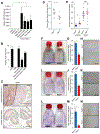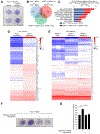Asporin Restricts Mesenchymal Stromal Cell Differentiation, Alters the Tumor Microenvironment, and Drives Metastatic Progression
- PMID: 31123087
- PMCID: PMC6734938
- DOI: 10.1158/0008-5472.CAN-18-2931
Asporin Restricts Mesenchymal Stromal Cell Differentiation, Alters the Tumor Microenvironment, and Drives Metastatic Progression
Abstract
Tumor progression to metastasis is not cancer cell autonomous, but rather involves the interplay of multiple cell types within the tumor microenvironment. Here we identify asporin (ASPN) as a novel, secreted mesenchymal stromal cell (MSC) factor in the tumor microenvironment that regulates metastatic development. MSCs expressed high levels of ASPN, which decreased following lineage differentiation. ASPN loss impaired MSC self-renewal and promoted terminal cell differentiation. Mechanistically, secreted ASPN bound to BMP-4 and restricted BMP-4-induced MSC differentiation prior to lineage commitment. ASPN expression was distinctly conserved between MSC and cancer-associated fibroblasts (CAF). ASPN expression in the tumor microenvironment broadly impacted multiple cell types. Prostate tumor allografts in ASPN-null mice had a reduced number of tumor-associated MSCs, fewer cancer stem cells, decreased tumor vasculature, and an increased percentage of infiltrating CD8+ T cells. ASPN-null mice also demonstrated a significant reduction in lung metastases compared with wild-type mice. These data establish a role for ASPN as a critical MSC factor that extensively affects the tumor microenvironment and induces metastatic progression. SIGNIFICANCE: These findings show that asporin regulates key properties of mesenchymal stromal cells, including self-renewal and multipotency, and asporin expression by reactive stromal cells alters the tumor microenvironment and promotes metastatic progression.
©2019 American Association for Cancer Research.
Conflict of interest statement
Disclosure of Potential Conflicts of Interest
Elai Davicioni is the President and CSO, Director of GenomeDx. Ben H. Park is a consultant for Foundation Medicine, Roche, H3 Biomedicine, Casdin Capital, Loxo Oncology, and Lilly, all outside the submitted work. No potential conflicts of interest were disclosed by the other authors.
Figures







Similar articles
-
Asporin is a stromally expressed marker associated with prostate cancer progression.Br J Cancer. 2017 Mar 14;116(6):775-784. doi: 10.1038/bjc.2017.15. Epub 2017 Feb 2. Br J Cancer. 2017. PMID: 28152543 Free PMC article.
-
Germline Variants in Asporin Vary by Race, Modulate the Tumor Microenvironment, and Are Differentially Associated with Metastatic Prostate Cancer.Clin Cancer Res. 2016 Jan 15;22(2):448-58. doi: 10.1158/1078-0432.CCR-15-0256. Epub 2015 Oct 7. Clin Cancer Res. 2016. PMID: 26446945 Free PMC article.
-
Loss of let-7 microRNA upregulates IL-6 in bone marrow-derived mesenchymal stem cells triggering a reactive stromal response to prostate cancer.PLoS One. 2013 Aug 19;8(8):e71637. doi: 10.1371/journal.pone.0071637. eCollection 2013. PLoS One. 2013. PMID: 23977098 Free PMC article.
-
Roles of cell fusion between mesenchymal stromal/stem cells and malignant cells in tumor growth and metastasis.FEBS J. 2021 Mar;288(5):1447-1456. doi: 10.1111/febs.15483. Epub 2020 Jul 24. FEBS J. 2021. PMID: 33070450 Review.
-
Crosstalk of tumor stromal cells orchestrates invasion and spreading of gastric cancer.Pathol Int. 2022 Apr;72(4):219-233. doi: 10.1111/pin.13211. Epub 2022 Feb 3. Pathol Int. 2022. PMID: 35112770 Review.
Cited by
-
A Review of Advances in Mitochondrial Research in Cancer.Cancer Control. 2024 Jan-Dec;31:10732748241299072. doi: 10.1177/10732748241299072. Cancer Control. 2024. PMID: 39487853 Free PMC article. Review.
-
Identification of 4-genes model in papillary renal cell tumor microenvironment based on comprehensive analysis.BMC Cancer. 2021 May 17;21(1):553. doi: 10.1186/s12885-021-08319-0. BMC Cancer. 2021. PMID: 33993869 Free PMC article.
-
TrkA overexpression in non-tumorigenic human breast cell lines confers oncogenic and metastatic properties.Breast Cancer Res Treat. 2020 Feb;179(3):631-642. doi: 10.1007/s10549-019-05506-3. Epub 2019 Dec 10. Breast Cancer Res Treat. 2020. PMID: 31823098 Free PMC article.
-
The Effects of Mesenchymal Stem Cell on Colorectal Cancer.Stem Cells Int. 2021 Jul 24;2021:9136583. doi: 10.1155/2021/9136583. eCollection 2021. Stem Cells Int. 2021. PMID: 34349805 Free PMC article. Review.
-
Reciprocal interplay between asporin and decorin: Implications in gastric cancer prognosis.PLoS One. 2021 Aug 11;16(8):e0255915. doi: 10.1371/journal.pone.0255915. eCollection 2021. PLoS One. 2021. PMID: 34379688 Free PMC article.
References
Publication types
MeSH terms
Substances
Grants and funding
LinkOut - more resources
Full Text Sources
Other Literature Sources
Medical
Molecular Biology Databases
Research Materials

